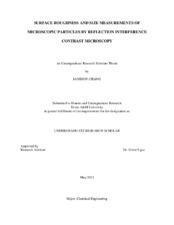| dc.creator | Chang, Jamison | |
| dc.date.accessioned | 2015-09-03T15:24:14Z | |
| dc.date.available | 2015-09-03T15:24:14Z | |
| dc.date.created | 2013-05 | |
| dc.date.issued | 2013-02-13 | |
| dc.date.submitted | May 2013 | |
| dc.identifier.uri | https://hdl.handle.net/1969.1/154861 | |
| dc.description.abstract | Accurate information about particle roughness and the deformation that occurs when a particle is in contact with a surface is needed to provide improved models of particle resuspension and adhesion. The capabilities of reflection interference contrast microscopy (RICM) in particle roughness measurements are explored in this study, by measuring the minimum separation distance between the particle and a flat substrate and possible roughness effects on the visibility of interference fringes. Monodisperse samples of polystyrene latex and glass beads were studied in order to compare surface roughness of different types of particles of similar size. Polydisperse samples of glass beads were also analyzed to compare particle size and surface roughness. Particle size and minimum separation distance values were measured with RICM taking into account surface roughness effects. It was shown that particle size data can be accurately obtained by RICM analysis, and the minimum separation distance that is measured by RICM can be used to show differences in surface roughness between different types of particles. | en |
| dc.format.mimetype | application/pdf | |
| dc.subject | Reflection Interference Contrast Microscopy | en |
| dc.subject | Particle surface roughness | en |
| dc.title | Surface Roughness and Size Measurements of Microscopic Particles by Reflection Interference Contrast Microscopy | en |
| dc.type | Thesis | en |
| thesis.degree.department | Chemical Engineering | en |
| thesis.degree.discipline | Chemical Engineering | en |
| thesis.degree.grantor | Honors and Undergraduate Research | en |
| dc.contributor.committeeMember | Ugaz, Victor M | |
| dc.type.material | text | en |
| dc.date.updated | 2015-09-03T15:24:14Z | |


